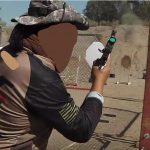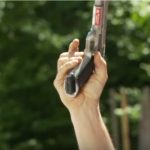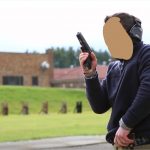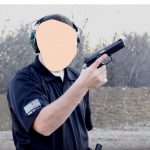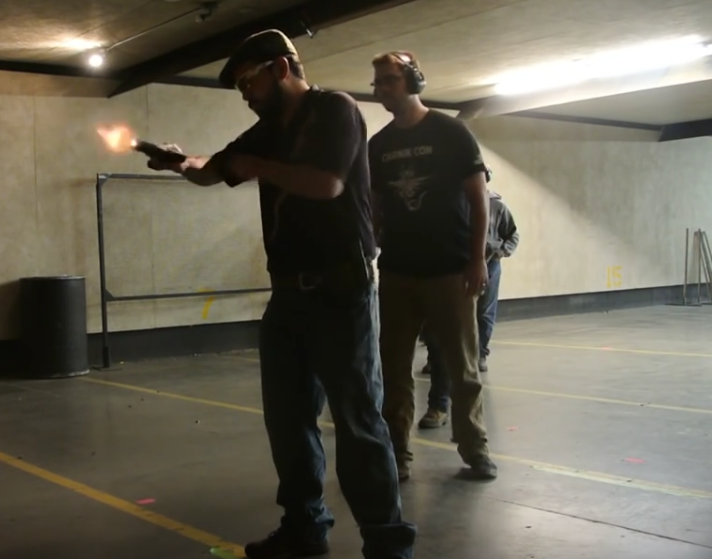Here is my working definition of a “safe direction” for non-emergency purposes:
A safe direction is a deliberately-chosen relationship between the muzzle of the gun and the surrounding area — one that will reliably bring all projectiles to rest without endangering human lives, even the lives of people we cannot necessarily see at the moment.[ref]For emergency purposes, the definition I use is, “Deliberately chosen as the best place to put a bullet in the immediate environment, and no unacceptable risk to the innocent is immediately apparent.”[/ref]
Note that within the meaning of the safety rules, a safe direction is always deliberately chosen. It does not happen on accident.
Occasionally, we read stories online from people who fired their guns unintentionally or even negligently (usually just before moaning, “I didn’t know the gun was loaded!”). As we read these stories, we find out that the people who fired the gun often must look for the path the bullet took — where did the bullet go once it left the room? Where did it finally stop? Did it hit a neighbor, a friend, a loved one? Did the unintentional shooter just kill his own wife or her own child? These stories often conclude with a sigh of relief: “… turned out the gun was pointed in a safe direction. I was following the safety rules!”
I beg to differ.
It only counts as following the safe-direction rule if the person handling the gun is in fact aware of the direction they’re pointing the muzzle at all times while they handle the gun. How many times have you seen someone in a gun store looking at the side of the gun while turning it this way and that, utterly oblivious to what the muzzle was doing even as other people ducked and moved away to avoid being covered? That person is not keeping the gun pointed in a safe direction, except by the merest good luck. They are not, in that moment, “following the safety rules.”
It also only counts if the person handling the gun is in fact aware of the quality of the backstop in that direction. The person handling the gun should reasonably believe — not just hope or suspect, but reasonably believe, which means they’ve thought about it — that the bullet would come to rest without punching through to hit someone unseen on the other side.
Bullets do punch straight through nearly all interior and most exterior walls of modern construction. Walls do not reliably stop bullets. (Neither do modern television sets, a different topic for another day.)
This means that we cannot simply announce that we have chosen an unreinforced wall as our designated “safe direction” and then forget about it. We can only call that wall a safe direction once we have done something to make sure that even the most unexpected bullet could not punch straight through that wall.
This is especially and particularly true for classroom settings where an instructor can, should, and MUST set up the environment to reliably deal with any unexpected live rounds.[ref]Unless the instructor chooses — as many professional instructors do — to not allow any handling of firearms inside the classroom at all.[/ref]
It is not enough to have the opinion that there’s (probably) no ammunition in the classroom environment. Or to say that the gun(s) we are handling are unloaded and have been so checked. Of course we believe we have unloaded the guns, and of course we have checked them to be sure!
But even after we have checked the guns, we still don’t ever toss those overlapping, redundant, ridiculously unnecessary safety rules straight out the window. Even though they overlap and are redundant and might even feel unnecessary. Nope. We follow the safety rules. Including the one that says we must keep the gun pointed in a safe direction.
In the heat of the moment, while defending your life from a violent criminal, you may not be able to use the safest-possible of all directions that you would have chosen if you’d had time to think about it or set up the circumstances to suit yourself in some more ideal world. That’s understood.
But what about when you are:
- Planning to handle the gun in your regular place where you do your dry practice or wherever you usually clean it?
- Planning to defend yourself inside your own home, where you have lots of time to think about the most likely ways for an assailant to enter, and consider your planned responses to each one?
- Planning to allow customers to handle guns inside your shop?
- Or planning to have students handle guns inside your classroom?
Keyword: planning. You betcha it matters then. And there are no excuses for failing to use a reliably safe direction in such circumstances. After all, you. are. planning.
If ever there was a time when excuses about bad backstops don’t apply, it’s when the person planned to handle the firearm, or planned to encourage others to handle firearms, in that area.
So as long as you are planning to handle a gun in a given area, plan to follow the safe direction rule, and plan for how you will do that. In fact, plan to follow all of the overlapping and redundant safety rules, every time you touch a firearm. Make it part of your mindset and build it into your habits.
In any environment where a person might have hours, days, weeks — possibly months or even years — to consider this issue before handling the gun there, there’s no excuse for NOT following this basic rule. We can easily plan to keep the gun pointed in a direction that would reliably bring the bullet to a stop without hurting anyone or anything other than its intended target.
There’s no reason at all to plan to put innocent people in deadly danger.
If such a direction does not naturally occur in a place where you intend to (or reasonably expect you might have to) handle a gun in the future, you can and should make a safe backstop to use in that area.
Recap:
- Plan for ways to follow the safe direction rule before you need to handle the gun.
- Handle firearms at home or in a classroom only when you can (and will!) keep the gun pointed at something that would reliably stop the bullet.
- If the area does not naturally include a place that you would trust to reliably stop a bullet, you must provide one or choose a different place to handle your gun — otherwise you are planning to break the safety rules.
- If there is no reliably safe direction in the area (and it’s not such an urgent case that someone would die-right-now if you did not pick up the gun and use it), refuse to touch that gun there. Refuse to remain in the area if anyone else does, either.
Refuse to become the victim of your own, or anyone else’s, poor choice for a gunhandling environment.

